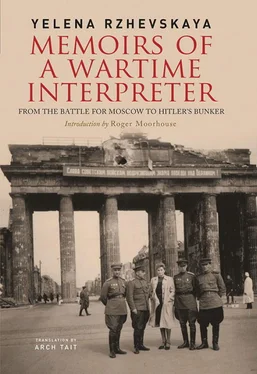So the bodies of Hitler and Eva Braun were in fact discovered on 4 May, but it was not realized what they were. ‘I did not report finding these bodies to anyone,’ Ivan Klimenko wrote to me in one of his letters (of 9 February 1965), responding later to my questions. That could have turned out to be a fatal mistake, but fortunately the information percolated through the same day. We already had enough facts to understand whom the soldiers had dug up. Colonel Gorbushin insisted that those who had made the discovery be brought back.
In that same letter, Klimenko tells me that when he returned to his Smersh unit, he himself ‘began to wonder whether those bodies we had reburied were the bodies of Hitler and Eva Braun’. This seemed all the more likely because, before leaving the Reich Chancellery, he had gone to look at the other ‘Hitler’ and learned he had been identified as ‘not the Führer’.
Klimenko sent the soldiers back to the Reich Chancellery under the command of his deputy, Captain Deryabin. The names of those who found the bodies are immortalized in a document drawn up the following day.
Berlin. Army on active service.
Declaration
This fifth day of the month of May 1945.
I, Senior Guards Lieutenant Alexey Alexandrovich Panasov, and Privates Ivan Dmitrievich Churakov, Yevgeny Stepanovich Oleynik and Ilia Yefremovich Seroukh in Berlin, in the area of Hitler’s Reich Chancellery, near the place where the bodies of Goebbels and his wife were discovered, next to Hitler’s personal bomb shelter, found and recovered two bodies, one female, the other male.
The bodies are badly burned, and it is not possible to identify them without further information.
The bodies were situated in a bomb crater three metres from the entrance to Hitler’s shelter and covered with a layer of earth.
Senior Guards Lieutenant (Panasov) Private Churakov Private Oleynik Private Seroukh
[1] File 126: Identification records, vol. 2
The ground in the crater was dug over and two dead dogs found, a sheepdog and a puppy.
A further declaration was drawn up:
We have found and recovered two slaughtered dogs.
Dogs’ characteristics:
1. German sheepdog (female) with dark grey fur, of large stature, having round its neck a collar in the form of a fine chain. No injuries or blood found on the body.
2. Of small stature (male), with black fur, without a collar, no injuries, bone of the upper half of the mouth punctured, blood in that area.
The bodies of the dogs were in a bomb crater 1.5 m apart under a light covering of earth.
There are grounds to believe that the killing of the dogs occurred 5–6 days ago, since there is no bad smell from the bodies and the fur is not becoming detached.
For the purpose of discovering items that might serve to confirm to whom these dogs belonged and the causes of their death, we carefully dug over and examined the soil at the place from where the bodies of the dogs were recovered. Here there were discovered:
1. Two dark-coloured glass tubes for medicine.
2. Sundry burnt sheets from typographically printed books and small scraps of paper with original handwriting.
3. A metal medallion of elliptical shape on a fine chain of beads 18–20 cm long, on the reverse side of which is an engraved inscription: ‘May I be always by your side.’
4. German currency amounting to 600 marks in notes of 100 marks.
5. A metal tag of elliptical form [with the number] 31907
The bodies of the dogs and the items discovered at the place of discovery and recovery have been photographed and are stored at the Smersh counterintelligence department of the corps, as witness the present Declaration.
Captain Deryabin Senior Guards Lieutenant Panasov Sergeant Tsibochkin Privates Alabudin, Kirillov, Korshak, Gulyaev.
The dogs were readily identified. The sheepdog was ‘Hitler’s personal dog’, as was written in another declaration. It was ‘tall, with long ears’. [1] Report of the forensic medical examination, in the same folder (File 126, vol. 2), 7 May 1945. Report of the forensic medical examination of the body of the German Führer.
It was light and windy. In the garden near the emergency exit of the bunker the soldiers stood in a circle: Churakov, Oleynik, Seroukh, Senior Lieutenant Panasov.
The wind was tugging at bits of burnt tin, wire, broken branches strewn around on the lawn.
On a grey blanket, contorted by fire, lay black, hideous human remains caked with lumps of mud.
I was there to witness that.
Without Mystification – Predictions
As dawn broke on 6 May, two bodies were heaved over the fence of the Reich Chancellery garden into a waiting truck and driven off.
That is the low cunning to which we were obliged to resort. The problem was that the 5th Assault Army, whose commander, General Berzarin, was the commandant of Berlin, was restoring order and clearing the Reich Chancellery and underground complex of all the people who had been flooding in. Sentries were posted at the entrance with orders to admit no one.
For us there was an added complication. For the intelligence services of the 5th Assault Army it remains to this day a source of enduring intolerable irritation that such a notable success was achieved on their patch not by them but by gatecrashers from our 3rd Shock Army. We were not about to leave our spoils in the hands of anybody else, abandoning the project before we had seen it through to a conclusion ourselves. So that was the ploy we resorted to: kidnapping the bodies of Hitler and Eva Braun, wrapped in sheets and, behind the backs of the sentries, spiriting them over the fence to where a truck with two large crates was waiting.
So began the posthumous adventures of Hitler’s body. We had sifted through all the details of his last days to establish everything that had happened, and had confirmation and the evidence that Hitler and Eva Braun had been hastily concealed in a bomb crater.
Back then, in May 1945, we managed to codify a great deal, to compare and understand facts and get a sense of the atmosphere surrounding the events. Twenty years later, going through the Council of Ministers archival materials that preserved the details of the last days of the Third Reich, I had an opportunity again to scrutinize those events and form a more complete picture. To this day new materials and documents are coming my way. Ultimately, Hitler succeeded in concealing nothing: neither his plans, his personal degradation, nor his death.
Into Bormann’s diary, into his routine registering of meetings with the Führer, receptions, the removal of some from senior positions and their replacement by others, suppers with Eva Braun, his receipt of decorations, various domestic matters, there suddenly bursts, menacingly displacing everything else, information about Soviet army groups attacking from all sides. In January the tone is still relaxed: ‘In the morning the Bolsheviks went on the offensive,’ and just before that we read, ‘Went with my wife and children to Reichenhall to inspect the mushroom farm (champignons) of the gardener Vollmark.’
The next day:
Sunday, 14 January. Visit to Aunt Häsken…
Saturday, 20 January. Noon. Situation in the east becoming more and more threatening. We have left Warthegau Province. The enemy’s front tank units are at Katowice…
Saturday, 3 February. In the morning, severe air raid on Berlin. (Damage from the bombing included the new Reich Chancellery, the hallway of Hitler’s apartment, the dining room, winter garden and Party Chancellery.)
Fighting for the fords on the Oder.
The bombing has damaged the façade of the Party Chancellery.
The bombing of Dresden, the enemy advance on Weimar, an air raid on Berlin.
Читать дальше











